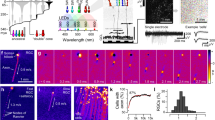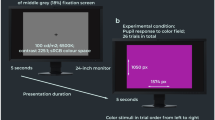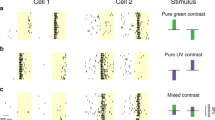Abstract
MR. E. N. WILLMER'S recent communications1, 2 on the physiology of colour vision once more direct attention to the essential principles involved in Thomas Young's theory. As is well known, it is on purely logical grounds that Young in 1801 came to the conclusion that the existence of three kinds of receptors having different spectral sensitivities— as we would say to-day—should account for the facts of normal colour vision3. At the basis of the theory lies4 the principle of the 'specific energy of nerves', formulated by J. Müller5 in 1840, according to which each nerve fibre can send only one kind of sensory message to the brain. This would seem to lead to the conclusion that there must be as many different kinds of receptors as there are colours; but Young's well-known hypothesis allows this number to be reduced to three. For the abnormal colour vision of such persons as his contemporary Dalton, Young himself suggested as an explanation "the absence or paralysis of those fibres of the retina which are calculated to perceive red"6; that is, dichromats would possess only two colour receptors instead of three. To-day the strength of this theoretical argument referring to the whole retina remains undiminished7, 8, 9, 10.
This is a preview of subscription content, access via your institution
Access options
Subscribe to this journal
Receive 51 print issues and online access
$199.00 per year
only $3.90 per issue
Buy this article
- Purchase on Springer Link
- Instant access to full article PDF
Prices may be subject to local taxes which are calculated during checkout
Similar content being viewed by others
References
Willmer, E. N., Nature, 151, 213 and 632 (1943).
Willmer, E. N., Nature, 153, 774 (1944).
Young, T., "On the Theory of Light and Colours", Phil. Trans. Roy. Soc., Part 1, 20 (1802). Reprinted in "Lectures on Natural Philosophy", 2, 613 (London, 1807).
König, A., "Gesammelte Abhandlungen zur Physiologischen Optik", 88 (Leipzig, 1903).
Müller, J., "Handbuch der Physiologie des Menschen" (Coblenz, 1840).
Young, T., note in the "Catalogue" in "Lectures on Natural Philosophy", 2, 315 (London, 1807).
Craik, K. J. W., Nature, 151, 727 (1943).
Hartridge, H., Nature, 151, 432 (1943); 152, 190 (1943); 153, 45 (1944).
Hecht, S., J. Opt. Soc. Amer., 20, 231 (1930).
Holbourn, A. H. S., Nature, 152, 190 (1943).
Hecht, S., Physiol. Rev., 17, 239 (1937).
Wentworth, H. A., Psychological Monographs, 40 (1930).
Mandelbaum, J., Arch. of Ophtalm., 26, 203 (1941).
Østerberg, G., Acta Ophtalm., Suppl. 6 (Copenhagen, 1935).
Walters, H. V., and Wright, W. D., Proc. Roy. Soc., B, 131, 340 (1943).
Wright, W. D., Nature, 151, 726 (1943).
Helmholtz, H. von, "Physiologische Optik", 2nd ed., 374 (Hamburg and Leipzig, 1896).
Hecht, S., and Shlaer, S., J. Gen. Physiol., 20, 83 (1936).
Author information
Authors and Affiliations
Rights and permissions
About this article
Cite this article
PIRENNE, M. Rods and Cones, and Thomas Young'S Theory of Colour Vision. Nature 154, 741–742 (1944). https://doi.org/10.1038/154741a0
Issue Date:
DOI: https://doi.org/10.1038/154741a0
This article is cited by
-
Retinal Summation and Human Visual Thresholds
Nature (1958)
-
[Letters to Editor]
Nature (1945)
-
[Letters to Editor]
Nature (1945)
-
Colour Sensitivity of the Fovea Centralis
Nature (1945)
Comments
By submitting a comment you agree to abide by our Terms and Community Guidelines. If you find something abusive or that does not comply with our terms or guidelines please flag it as inappropriate.



